Elevation 1,200 m Official languages Ganda, English | Time zone EAT (UTC+3) Area 61,403 km² | |
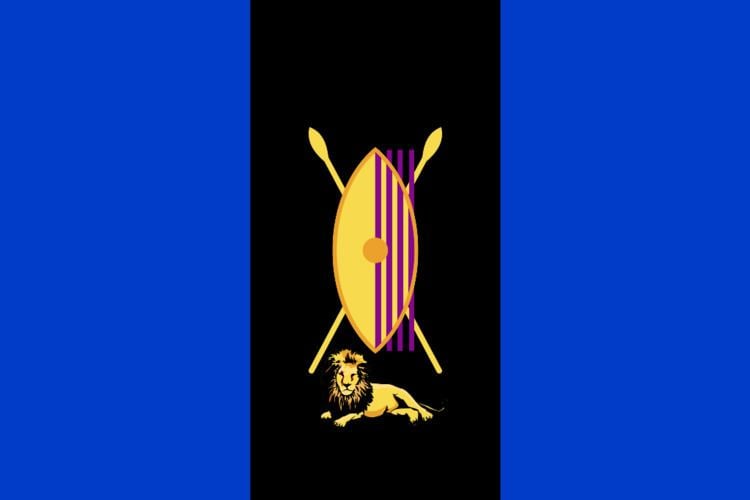 | ||
Government Monarchy, Hereditary Monarchy, Non-sovereign monarchy | ||
Buganda is a subnational kingdom within Uganda. The kingdom of the Ganda people, Buganda is the largest of the traditional kingdoms in present-day Uganda, comprising all of Uganda's Central Region, including the Ugandan capital Kampala. The 6 million Baganda (singular Muganda; often referred to simply by the root word and adjective, Ganda) make up the largest Ugandan ethnic group, representing approximately 16.9% of Uganda's population.
Contents
- Buganda kingdom 1800s 2012
- Location
- Language
- Geography and environment
- History of Buganda
- Attempted secession in Kayunga
- Social structure
- Culture
- Clans of Buganda
- Nansangwa
- Kintu migration
- Kimera migration
- Other clans
- Economy
- References
Buganda has a long and extensive history. Unified in the 14th century under the first king Kato Kintu, the founder of Buganda's Kintu Dynasty, Buganda grew to become one of the largest and most powerful states in East Africa during the eighteenth and 19th centuries. During the Scramble for Africa, and following unsuccessful attempts to retain its independence against British imperialism, Buganda became the centre of the Uganda Protectorate in 1894; the name Uganda, the Swahili term for Buganda, was adopted by British officials. Under British rule, many Baganda acquired status as colonial administrators, and Buganda became a major producer of cotton and coffee.

Following Uganda's independence in 1962, the kingdom was abolished by Uganda's first Prime Minister Milton Obote in 1966. Following years of disturbance under Obote and dictator Idi Amin, as well as several years of internal divisions among Uganda's ruling National Resistance Movement under Yoweri Museveni, the President of Uganda since 1986, the kingdom was officially restored in 1993. Buganda is now a kingdom monarchy with a large degree of autonomy from the Ugandan state, although tensions between the kingdom and the Ugandan government continue to be a defining feature of Ugandan politics.

Since the restoration of the kingdom in 1993, the king of Buganda, known as the Kabaka, has been Muwenda Mutebi II. He is recognised as the 36th Kabaka of Buganda. The current queen, known as the Nnabagereka, is Queen Sylvia Nagginda.
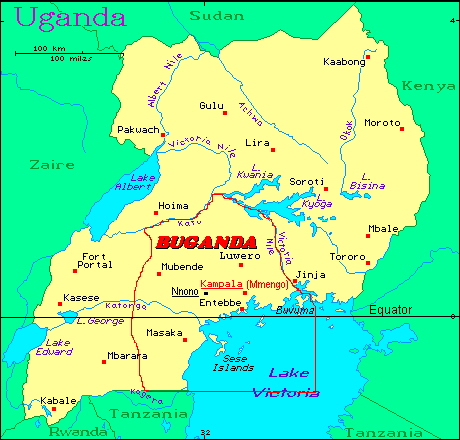
Buganda kingdom 1800s 2012
Location
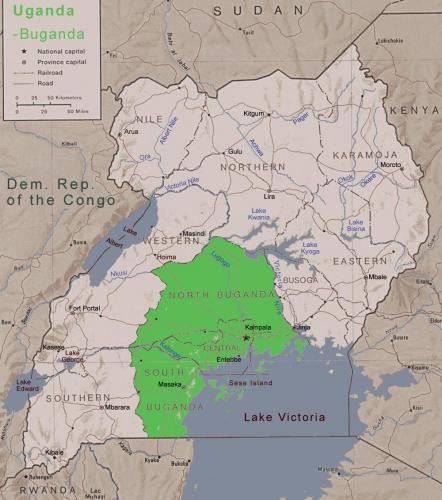
Buganda's boundaries are marked by Lake Victoria to the south, the River Nile to the east, Lake Kyoga to the north and River Kafu to the northwest. To the west, Buganda is bordered by the districts of Isingiro, Kiruhura, Kyenjojo, Kibale, Hoima and Masindi.
The following are the officially recognized counties (amasaza) of Buganda:
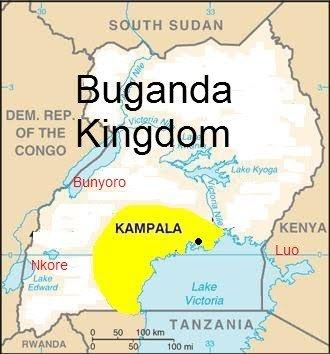
The counties are then divided into a variable number of sub-counties or gombolola(s) and each gombolola is then divided into parishes called miluka (singular: muluka). Two or more villages make up one muluka.
Language
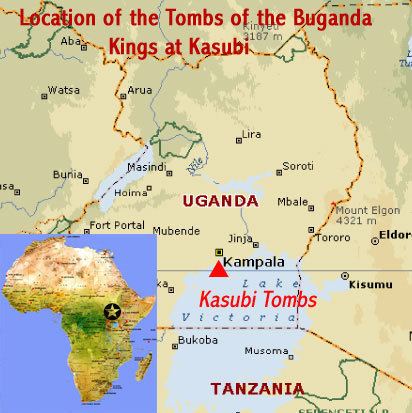
The Luganda language is widely spoken in Uganda, and is the most popular second language in Uganda along with English. It is also used as medium in lower primary and as a subject in primary and secondary schools in Uganda and as a subject at Makerere University, Uganda's oldest university and it has an exhaustive dictionary. The Luganda language was also used as a means of instruction in schools outside the region of Buganda prior to Uganda's Independence in 1962.
In literature and common discourse, Buganda is often referred to as Central Uganda. 'Central' was the name of one of the four regions into which Uganda was earlier divided, the others being Northern, Eastern and Western. Since the map of Uganda does not really have a south (as that is all Lake) Central was a fitting name and like the others ethnically neutral.
Geography and environment
Ganda villages, sometimes as large as forty to fifty homes, were generally located on hillsides, leaving hilltops and swampy lowlands uninhabited, to be used for crops or pastures. Early Ganda villages surrounded the home of a chief or headman, which provided a common meeting ground for members of the village. The chief collected tribute from his subjects, provided tribute to the Kabaka, who was the ruler of the kingdom, distributed resources among his subjects, maintained order, and reinforced social solidarity through his decision-making skills. During the late 19th century, Ganda villages became more dispersed as the role of the chiefs diminished in response to political turmoil, population migration, and occasional popular revolts.
History of Buganda
The kingdom of Buganda is situated in swampy hillsides which served as a refuge for those escaping rivalries in neighboring Bunyoro. One faction fleeing Bunyoro, under the leadership of Prince Kimera, arrived in Buganda toward the last quarter of the 14th century. The prince molded the already existing refugees in the area into a unified state and became the third Kabaka (ruler) of Buganda.
By the 18th century, the formerly dominant Bunyoro kingdom was being eclipsed by Buganda. Consolidating their efforts behind a centralized kingship, the Baganda (people of Buganda) shifted away from defensive strategies and toward expansion. By the mid-19th century, Buganda had doubled and redoubled its territory conquering much on Bunyoro and becoming the dominant state in the region. Newly conquered lands were placed under chiefs nominated by the king. Buganda's armies and the royal tax collectors traveled swiftly to all parts of the kingdom along specially constructed roads which crossed streams and swamps by bridges and viaducts. On Lake Victoria (which the Ganda called Nnalubale), a royal navy of outrigger canoes, commanded by an admiral who was chief of the Lungfish clan, could transport Baganda commandos to raid any shore of the lake.
The journalist Henry Morton Stanley visited Buganda in 1875 and provided an estimate of Buganda troop strength. Stanley counted 3,000 troops and a fleet of war canoes. At Buganda's capital, Lubaga, Stanley found a well-ordered town surrounding the king's palace, which was situated atop a commanding hill. A tall cane fence surrounded the palace compound, which was filled with grass-roofed houses, meeting halls, and storage buildings. Thronging the grounds were foreign ambassadors. seeking audiences, chiefs going to the royal advisory council, messengers running errands, and a corps of young pages. He estimated the population of the kingdom at 2,000,000
The British were impressed with government of Buganda. Under Kabaka Mwanga II, Buganda became a protectorate in 1894. This did not last and the Kabaka declared war on Britain in on July 6, 1897. He was defeated at the battle of Buddu on July 20 of the same year. He fled to German East Africa where he was arrested and interned at Bukoba. The Kabaka later escaped and led a rebel army to retake the kingdom before being defeated once again in 1898 and being exiled to the Seychelles.
While in exile, Mwanga II was received into the Anglican Church, was baptized with the name of Danieri (Daniel). He spent the rest of his life in exile. He died in 1903, aged 35 years. In 1910 his remains were repatriated and buried at Kasubi.
Kabaka Mwanga II Buganda was allowed near complete autonomy and a position as overlord of the other kingdoms.
The war against Kabaka Mwanga II had been expensive, and the new commissioner of Uganda in 1900, Sir Harry H. Johnston, had orders to establish an efficient administration and to levy taxes as quickly as possible. Sir Johnston approached the chiefs in Buganda with offers of jobs in the colonial administration in return for their collaboration. The chiefs did so but expected their interests (preserving Buganda as a self-governing entity, continuing the royal line of kabakas, and securing private land tenure for themselves and their supporters) to be met. After much hard bargaining, the chiefs ended up with everything they wanted, including one-half of all the land in Buganda. The half left to the British as "Crown Land" was later found to be largely swamp and scrub.
Johnston's Buganda Agreement of 1900 imposed a tax on huts and guns, designated the chiefs as tax collectors, and testified to the continued alliance of British and Baganda interests. The British signed much less generous treaties with the other kingdoms (Toro in 1900, Ankole in 1901, and Bunyoro in 1933) without the provision of large-scale private land tenure.
Following Uganda's independence in 1962, the kingdom was abolished by Uganda's first Prime Minister Milton Obote in 1966. Following years of disturbance under Obote and dictator Idi Amin, as well as several years of internal divisions among Uganda's ruling National Resistance Movement under Yoweri Museveni, the President of Uganda since 1986, the kingdom was finally restored in 1993. Buganda is now a kingdom monarchy with a large degree of autonomy from the Ugandan state, although tensions between the kingdom and the Ugandan government continue to be a defining feature of Ugandan politics.
Attempted secession in Kayunga
In September 2009, some members of the Banyala tribe led by Isabanyala Baker Kimeze announced that Bugerere had seceded from the Kingdom of Buganda. Because of the resulting tensions, the government of Uganda stopped the Kabaka of Buganda from traveling to Bugerere, leading to riots in the capital Kampala and neighboring districts. Thirty were killed in what came to be known as the Buganda riots.
Social structure
Ganda social organization emphasized descent through males. Four or five generations of descendants of one man, related through male forebears, constituted a patrilineage. A group of related lineages constituted a clan. Clan leaders could summon a council of lineage heads, and council decisions affected all lineages within the clan. Many of these decisions regulated marriage, which had always been between two different lineages, forming important social and political alliances for the men of both lineages. Lineage and clan leaders also helped maintain efficient land use practices, and they inspired pride in the group through ceremonies and remembrances of ancestors.
Most lineages maintained links to a home territory (butaka) within a larger clan territory, but lineage members did not necessarily live on butaka land. Men from one lineage often formed the core of a village; their wives, children, and in-laws joined the village. People were free to leave if they became disillusioned with the local leader to take up residence with other relatives or in-laws, and they often did so.
Culture
The family in Buganda is often described as a microcosm of the kingdom. The father is revered and obeyed as head of the family. His decisions are generally unquestioned. A man's social status is determined by those with whom he establishes patron/client relationships, and one of the best means of securing this relationship is through one's children. Baganda children, some as young as three years old, are sent to live in the homes of their social superiors, both to cement ties of loyalty among parents and to provide avenues for social mobility for their children. Even in the 1980s, Baganda children were considered psychologically better prepared for adulthood if they had spent several years living away from their parents at a young age.
Baganda recognize at a very young age that their superiors, too, live in a world of rules. Social rules require a man to share his wealth by offering hospitality, and this rule applies more stringently to those of higher status. Superiors are also expected to behave with impassivity, dignity, self-discipline, and self-confidence, and adopting these mannerisms sometimes enhances a man's opportunities for success.
Authoritarian control is an important theme of Ganda culture. In precolonial times, obedience to the king was a matter of life and death. However, a second major theme of Ganda culture is the emphasis on individual achievement. An individual's future is not entirely determined by status at birth. Instead, individuals carve out their fortunes by hard work as well as by choosing friends, allies, and patrons carefully.
Ganda culture tolerates social diversity more easily than many other African societies. Even before the arrival of Europeans, many Ganda villages included residents from outside Buganda. Some had arrived in the region as slaves, but by the early 20th century, many non-Baganda migrant workers stayed in Buganda to farm. Marriage with non-Baganda was fairly common, and many Baganda marriages ended in divorce. After independence, Ugandan officials estimated that one-third to one-half of all adults marry more than once during their lives.
Clans of Buganda
As of 2009, there are at least fifty two (52) recognised clans within the kingdom, with at least another four making a claim to clan status. Within this group of clans are four distinct sub-groups which reflect historical waves of immigration to Buganda.
Nansangwa
The oldest clans trace their lineage to Bakiranze kiva Bulaya, who are supposed to have ruled in the region from about 400 AD until about 1300 AD. These seven clans are referred to as the Nansangwa, or the indigenous:
- Lugave (Pangolin)
- Mmamba (Lungfish)
- Ngeye (Colobus monkey)
- Njaza (Reedbuck)
- Ennyange (Cattle egret)
- Fumbe (Civet cat)
- Ngonge (Otter)
Kintu migration
The Abalasangeye dynasty came to power through the conquests of Kabaka Kato Kintu, which are estimated to have occurred sometime between 1200 and 1400 AD.
Thirteen clans are purported to have come with Kintu:
- Ekkobe (Liana fruit)
- Mbwa (Dog)
- Mpeewo (Oribi antelope)
- Mpologoma (Lion)
- Namuŋoona (Pied crow)
- Ngo (Leopard)
- Ŋonge (Otter)
- Njovu (Elephant)
- Nkejje (Sprat)
- Nkima (Vervet monkey)
- Ntalaganya (Blue duiker)
- Nvubu (Hippopotamus)
- Nvuma (Pearl)
The descendants of the Basimba people (also known as Bashimba) which is a Bisa and Ambo nickname of the Clan of the leopards, the bena Ngo in Zambia, who settled at Mpogo, Sironko District, might have been among of the Ngo Clan group that come along with Kabaka Kato Kintu.
Kimera migration
Around 1370 AD another wave of immigration assisted by Kabaka Kimera, who was the son of Omulangira Kalemeera. Kabaka Kimera was born in Kibulala, and returned to Buganda with Jjumba of the Nkima clan and other Buganda elders.
These eleven clans are:
- Bugeme
- Butiko (Mushrooms)
- Kasimba (Genet)
- Kayozi (Jerboa)
- Kibe (Fox)
- Mbogo (Buffalo)
- Musu/Omusu (Edible rat)
- Ngabi (Bushbuck)
- Nkerebwe (Jungle Shrew)
- Nsuma (Elephant-snout fish)
- Nseenene (Edible grasshopper)
Other clans
Since Kabaka Kimera twenty further clans have either immigrated to Buganda, or been created internally (largely by kings). These clans are:
- Abalangira(Descendants of male Royalty from Buganda)
- Babiito (Descendants of male Royalty from Bunyoro)
- Basambo
- Baboobi (Millipede)
- Kasanke (Finch with black wings and white chest)
- Kikuba (A pad used to brush aside morning dew when walking through tall grass)
- Kinyomo (Type of ant)
- Kiwere (Purple dye plant)
- Lukato (Stiletto or awl)
- Mbuzi (Goat)
- Mpindi (Cowpea)
- Mutima muyanja (Heart)
- Mutima musajji
- Nakinsige (Brown grass finch)
- Ndiga (Sheep)
- Ndiisa (small basket used for coffee berries)
- Ŋŋaali (Crested crane)
- Njobe (Marsh antelope)
- Nkebuka (Red finch)
- Nkula (Rhinoceros)
- Nsunu (Kob)
- Nte (Ox or cow)
- Nswaaswa (Monitor lizard)
Economy
The traditional Ganda economy relied on crop cultivation. In contrast with many other East African economic systems, cattle played only a minor role. Many Baganda hired laborers from outside Buganda to herd the Baganda's cattle, for those who owned livestock. Bananas were the most important staple food, providing the economic base for the region's dense population growth. This crop does not require shifting cultivation or bush fallowing to maintain soil fertility, and as a result, Ganda villages were quite permanent. Women did most of the agricultural work, while men often engaged in commerce and politics (and in precolonial times, warfare). Before the introduction of woven cloth, traditional clothing was manufactured from the bark of trees.
